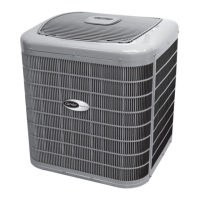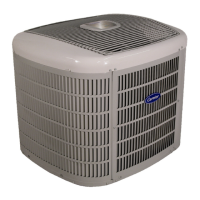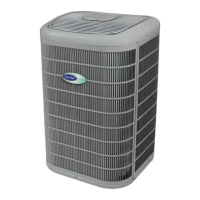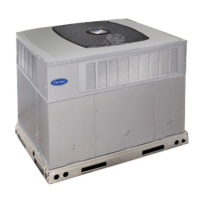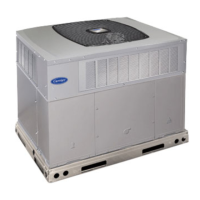10
Compressor Voltage Sensing
The control board input terminals labeled VS and L2 (see Fig. 7)
are used to detect compressor voltage status, and alert the user of
potential problems. The control continuously monitors the high
voltage on the run capacitor of the compressor motor. Voltage
should be present any time the compressor contactor is energized,
and voltage should not be present when the contactor is
de--energized.
Contactor Shorted Detection
If there is compressor voltage sensed when there is no demand for
compressor operation, the contactor may be stuck closed or there is
a wiring error. The control will flash the appropriate fault code.
Compressor Thermal Cutout
If the control senses the compressor voltage after start--up, and is
then absent for 10 consecutive seconds while cooling demand
exists, the thermal protector is open. The control de--energizes the
compressor contactor for 15 minutes, but continues to operate the
outdoor fan.
The control Status LED will flash the appropriate code shown in
Table 6. After 15 minutes, with a call for low or high stage cooling,
the compressor contactor is energized. If the thermal protector has
not reset, the outdoor fan is turned off. If the call for cooling
continues, the control will energize the compressor contactor every
15 minutes. If the thermal protector closes, (at the next 15 minute
interval check), the unit will resume operation. If the thermal
cutout trips for three consecutive cycles, then unit operation is
locked out for 4 hours and the appropriate fault code is displayed.
No 230V at Compressor
If the compressor voltage is not sensed when the compressor
should be starting, the appropriate contactor may be stuck open or
there is a wiring error. The control will flash the appropriate fault
code. Check the contactor and control box wiring.
Troubleshooting units for proper switching
between low & high stages
Check the suction pressures at the service valves. Suction pressure
should be reduced by 3--10% when switching from low to high
capacity.
NOTE: The liquid pressures are very similar between low and
high stage operation so liquid pressure should not be used for
troubleshooting.
Compressor current should increase 20 to 45% when switching
from low to high stage. The compressor solenoid when energized
in high stage, should measure 24vac across pin numbers PL5--2 HI
and PL5--5 C . When the compressor is operating in low stage, the
24v DC compressor solenoid coil is de--energized. When the
compressor is operating in high stage, the 24v DC solenoid coil is
energized.
The solenoid plug harness that is connected to the compressor has
an internal rectifier that converts the 24v AC signal to 24v DC.
DO NOT INSTALL A PLUG WITHOUT AN INTERNAL
RECTIFIER.
Unloader Test Procedure
The unloader is the compressor internal mechanism, controlled by
the DC solenoid, that modulates between high and low stage. If it
is suspected that the unloader is not working, the following
methods may be used to verify operation.
1. Operate the system and measure compressor amperage.
Cycle the unloader on and off at 30 second plus intervals at
the UI (from low to high stage and back to low stage). Wait
5 seconds after staging to high before taking a reading. The
compressor amperage should go up or down at least 20 per-
cent.
2. If step one does not give the expected results, remove the
solenoid plug from the compressor and, with the unit run-
ning and the UI (or Thermostat) calling for high stage, test
the voltage output at the plug with a DC voltmeter. The
reading should be 24 volts DC.
3. If the correct DC voltage is at the control circuit molded
plug, measure the compressor unloader coil resistance. The
resistance should be approximately 330 or 1640 ohms de-
pending on unloader coil supplier. If the coil resistance is
infinite or is grounded, the compressor must be replaced.
MAJOR COMPONENTS
2--Stage Control
The 2--stage control board controls the following functions:
— Compressor high and low stage operation
— Outdoor fan motor operation
— Low ambient cooling
— Compressor external protection
— Pressure switch monitoring
— Time delays
Field Connections
On models with non--communicating (non--Infinity) system, the
2--stage control receives 24vac low--voltage control system inputs
through the C, Y1, and Y2 connections located at the bottom of the
control board (see Fig. 7). The OD units can be controlled using a
standard 2--stage thermostat or Infinity User Interface.
2--Stage Compressor
The 2--stage compressor contains motor windings that provide
2--pole (3500 RPM) operation. Refer to Table 4 for correct
winding resistance.
Compressor Internal Relief
The compressor is protected by an internal pressure relief (IPR)
which relieves discharge gas into compressor shell when
differential between suction and discharge pressures exceeds 550 --
625 psig The compressor is also protected by an internal overload
attached to motor windings.
Compressor Control Contactor
The contactor has a 24 volt coil. The electronic control board
controls the operation of the appropriate contactor.
24ANB7 / 24ANB1
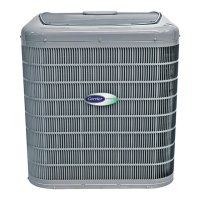
